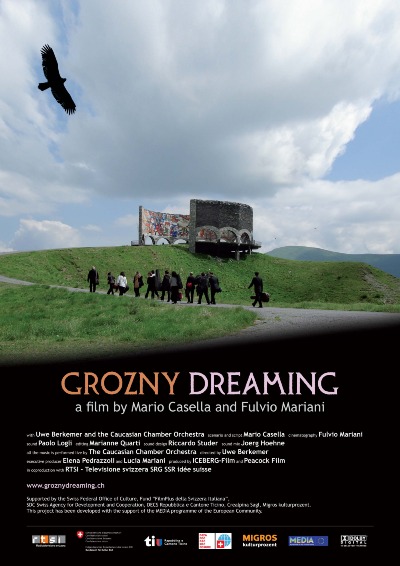Grozny Dreaming
| 2008 |
 |
documentary, 95 min. |
https://peacock.ch/images/images/images/images/images/images/images/
| Director Statement |
| Note of intent by the authors
A chamber orchestra of musicians from all the Caucasian republics and a German
conductor initiated this bold project whose aim is to show that it is indeed possible to
live and work together, side by side, even among people from different religions,
cultures and ethnic origins. In 2007, the orchestra, which was created a few years
back in Tiflis (Georgia), will set out on an ambitious project: a peace tour through the
Caucasus. At the conclusion, the musicians would like to cap this experience with a
dream: a concert in Grozny. This documentary will show the genesis of this project
and backstage events, as well as the joys and pains of a musical project whose notes
will resound in the mountains of the Caucasus, for centuries the theatre of wars,
massacres and interethnic tensions.
A chamber orchestra is usually composed of 16 to 19 musicians. The Caucasus
Chamber Orchestra plays with 16 regular members and three empty seats. These
seats are reserved for the musicians from Azerbaijan. As the group includes
Armenians – considered their historical enemies – no musician from Azerbaijan has up
until now agreed to become part of the orchestra.
The objective of the musical project is to bring a message of peace to the Caucasus
region by demonstrating that it is possible, as the orchestra shows, to live together
and even make a utopia come true, providing that conflicts and tensions are overcome.
The documentary proposes to take advantage of this courageous Trans-Caucasian
tour through all the republics situated on either side of a mountain range between
Asia and Europe, by presenting a portrait of some members of this chamber
orchestra. This unique group brings together approximately 40 languages and
dialects, not to mention a wide range of cultures, stories, biographies, etc. After an initial interview with the conductor, we have obtained his support for the
documentary and, during the summer of 2006, our plan is to proceed to the first
location reconnoitring and character selection.
The film will propose to the viewers a musical and intimate journey through the
Caucasus as seen from within the group: a diary which will record practical and
logistic difficulties, as well as moments of discouragement and of success during
their tour in one of the world’s most tension ridden regions. How will the group travel
on the bus from one republic to the next? How will they be received at the various
stages? How will interpersonal relationships in the group be managed?
During the journey, the camera will focus on a few key personalities who will be
selected in advance.
In the summer of 2006, the author and the director, having already obtained the
agreement of the conductor, spent one week with the group in order to find and
screen the characters around which the narration will be based.
During the actual production stage, scheduled for 2007, these people will be filmed
not only during concerts, but also at various times in their homes with their families
in their own homelands (Dagestan Georgia, Armenia, Chechnya, etc. ).
The narration will also focus on the characters’ relationship with their musical
instrument (violin, double bass, viola, etc.)
Given the quality and type of music played by the group, much effort will be devoted
to the quality of the sound recordings which will make up the sound track of the
documentary.
The main character of the documentary will be the conductor Uwe Berkemer who is
both the conceiver and the driving force behind this initiative. The story of Maestro
Berkemer’s life and his arrival in Georgia, where he married one of the group’s
musicians, will form an important part of this film.
The narration will be centred on the ending and on the central question related in the
documentary: will the Chamber Orchestra of the Caucasus succeed in holding its final
concert in Grozny at the end of its “peace tour� We will find this out at the end of the filming. |
|

